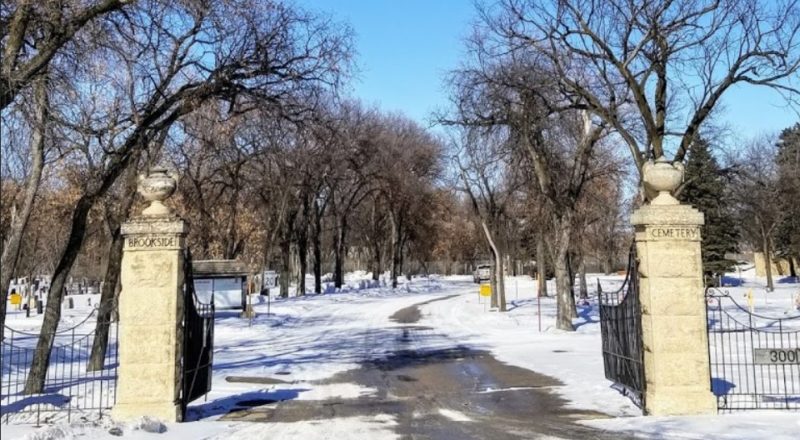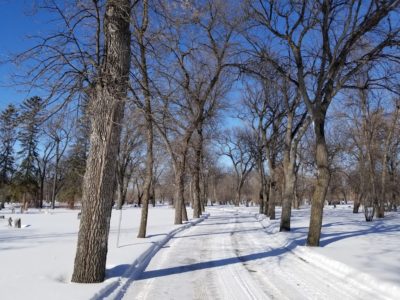
/ Blog
March 5, 2020
National Honour Pending for Brookside Cemetery
At the City of Winnipeg’s Standing Policy Committee on Property and Development, Heritage and Downtown Development meeting on March 2nd, 2020, Councillors voted unanimously to nominate Brookside Cemetery at 3001 Notre Dame Avenue as a National Historic Site. It will then go to the next Council meeting for final approval to proceed. This is just the first step of a longer process, but it is a move in the right direction to protect one of Winnipeg’s oldest cemeteries.
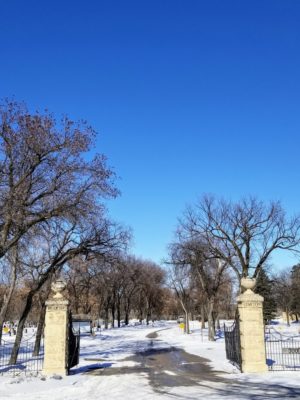 |
| The entrance gates to Brookside Cemetery. Source: Sabrina Janke for Heritage Winnipeg. |
Typically, when we think of heritage, we think of built structures – like commercial and institutional buildings and residential that make up so much of our cities urban landscape, but heritage can be much broader than this. Cultural and natural landscapes can have significant heritage value to communities and are equally deserving of recognition and protection.
Cemeteries, as historic sites, offer a mix of both natural and built heritage, and one cannot exist without the other. Manmade structures like mausoleums and administrative offices mingle with landscaping and tree-lined walkways. Cemeteries also offer us valuable insight into the past. The Government of Newfoundland and Labrador, in their Municipal Designation of Cemeteries and the Historic Places Initiative Report, reminds us that “[Cemeteries] occupy both emotional and physical space in our communities. Cemeteries are also expressions of our spiritual beliefs and cultural values, as well as rich repositories of genealogical and community history.”
 |
| The mid-century administration building in Brookside Cemetery is an example of built heritage coexisting inside of a cultural landscape. Source: Sabrina Janke for Heritage Winnipeg. |
To date, just three cemeteries in Winnipeg are designated as municipal heritage sites (St. John’s Anglican Church & Cemetery, St. James Anglican Church & Cemetery and St. Boniface Cathedral and Cemetery)and no cemetery in Winnipeg has yet received the status of National Historic Site. Designation carries significant benefits including national recognition, increased tourism, and access to subsidy programs like the National Cost-Sharing program that will help cover the costs of maintenance and preservation. Brookside Cemetery is a natural choice for this distinct honour!
It is one of Winnipeg’s oldest cemeteries, owned and operated by the City of Winnipeg since 1878. Many of Winnipeg’s other cemeteries at the time, like the cemetery at the St. John’s Anglican church, were either run by a church or privately owned and burial costs could be expensive. The motivation behind the creation of Brookside, then, was to provide a resting place for citizens without families to bury them and for those who weren’t affiliated with any particular church. As a result, people from all walks of live are buried here: from famous politicians, artists and athletes, to the homeless and nameless. More opulent markers paid for by wealthy families are intermingled with smaller more modest tombstones, and not all of them bear names. Not much is known about the lives of these individuals, but some of these nameless graves are for the 400 victims of the 1920s influenza epidemic. All in all, over 97,000 people are buried in Brookside Cemetery and their tombstones help to tell the story of our city.
 |
| Headstones of varying shapes and sizes stick up through the snow. Source: Sabrina Janke for Heritage Winnipeg. |
Scattered throughout the cemetery are famous Winnipeg figures such as: Francis Evans Cornish, Winnipeg’s first mayor and notorious troublemaker (and the namesake of the Cornish Library), and Corliss and Harriet Walker, owners and operators of the Walker Theatre. There’s also Mike Sokolowski and Steve Szczerbanowicz, the two men who were shot and killed during the Bloody Saturday Riot of the 1919 General Strike. Until recently, both of these men were buried in unmarked graves and it is known exactly why this was the case. Regardless, in 2003 Mike Sokolowski finally received a tombstone as a part of Brookside Cemetery’s 125th anniversary. Szczerbanowicz’s tombstone came later, in 2015, after years of fundraising.
These two Ukrainian immigrants are not the cemetery’s only connection to the 1919 General Strike; Fred Dixon, a strike leader, is also buried in Brookside Cemetery. As is John Queen, strike leader and Winnipeg mayor. There’s also Matilda Russell, a department store employee who was arrested for urging her coworkers to strike. The wealth of connections to the Winnipeg General Strike prompted researcher and labour advocate Paul Moist to create a tour of the cemetery themed around the strike.
Moist is one of many interested in researching the history of Brookside Cemetery, and interpretive signage has been added for the curious visitor. The bulk of the plaques found around the winding pathways were installed in 2003, as part of Brookside’s 125th anniversary. A map, made by the City of Winnipeg with the help of Red River College design students, guides visitors throughout the park while sturdier metal signage demarcates the burial spaces of well-known figures. Following the signage, you find the final resting place of war hero Tommy Prince, Harry Coleburn (of Winnipeg the Pooh fame) and the victims of the 1947 Dugald Rail Accident. For those who are unable to make the trek, two volumes of Brookside Cemetery: A Celebration of Life have been published on the history of the cemetery and its inhabitants.
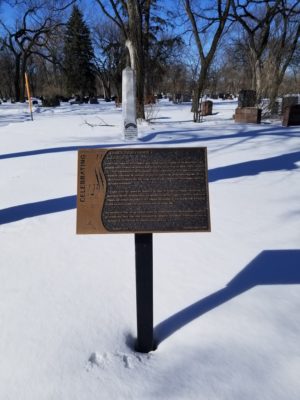 |
| One of the anniversary plaques found throughout the park; this particular one gives a biography of Mayor Francis Evans Cornish. Source: Sabrina Janke for Heritage Winnipeg. |
Of particular interest is the Field of Honour, the final resting place for more more than 11,000 veterans and peacekeepers from the First World War, Second World War, Korean War, Vietnam War, and from the Canadian forces. The Field of Honour is the both the oldest and largest site of its kind in Canada, and takes up much of the cemetery. Further, the distinctive Cross of Sacrifice found on the northern edge of the cemetery is one of only 24 in Canada.
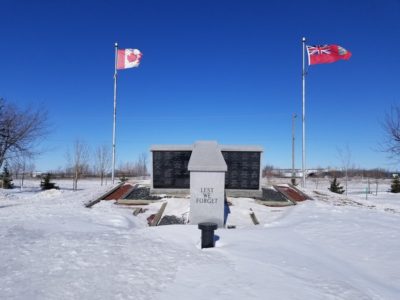 |
| The Cross of Sacrifice, built to honour the veterans of the First and Second World Wars, stands at the northern edge of the cemetery. Source: Sabrina Janke for Heritage Winnipeg. |
 |
| A small section of the Field of Honour. Source: Sabrina Janke for Heritage Winnipeg. |
In 1995, the war memorials underwent a significant restoration project that removed and replaced 4684 markers on the site. This process, and the meaning behind the symbols on the war memorial tombstones, are explained in four small memorial stones. In 2016, the Government of Manitoba recognized Brookside Cemetery as an honourary provincial cemetery.
The Field of Honour, with it’s size and significance, is the focal point of the cemetery’s nomination as a National Historic Site. What, then, does a nomination actually mean?
Well, first things first: the City of Winnipeg will submit a nomination form to the Historic Sites and Monuments Board of Canada, Parks Canada historians will then begin a preliminary study of the history of Brookside Cemetery.A year after this report is prepared, it is passed along to the Minister of Environment and Climate Change for their approval, which can take up to another year. If the Minister approves this application then the city will be contacted, and Brookside Cemetery will officially become a National Historic Site.
All in all, this process can take up to a total of two years, and if time is on our side, and the result is favourable, Brookside Cemetery could be looking at an official National Historic Site designation just in time to celebrate Winnipeg’s 150th anniversary in 2023!
SOURCES:
City of Winnipeg PP&D March 2nd 2020 Meeting Agenda
Brookside Cemetery | City of Winnipeg
Brookside Cemetery Field of Honour | City of Winnipeg
Municipal Designation of Cemeteries and the Historic Places Initiative | Government of Newfoundland and Labrador
Walk Through History: Winnipeg Free Press
Winnipeg General Strike of June 21, 1919: Two Ukrainians Killed | Winnipeg Sun
Teeming with Life, History: Winnipeg’s Brookside Cemetery: The Manitoban
Brookside Cemetery Turns 125 Years Old | Winnipeg Free Press
National Cost Sharing Program for Historic Places | Parks Canada
THANK YOU TO THE SPONSOR OF THIS BLOG POST:

Written by Sabrina Janke on behalf of Heritage Winnipeg.





